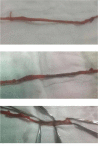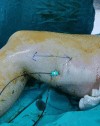The Effectiveness of Endovenous Radiofrequency Ablation Application in Varicose Vein Diseases of the Lower Extremity
- PMID: 32399372
- PMCID: PMC7216314
- DOI: 10.7759/cureus.7640
The Effectiveness of Endovenous Radiofrequency Ablation Application in Varicose Vein Diseases of the Lower Extremity
Abstract
We aimed to determine the outcome, complications, and quality of life effects of radiofrequency ablation (RFA) in the treatment of superficial venous insufficiency. A total of 134 extremities from 100 patients were evaluated in this retrospective study performed at the Cardiovascular Surgery Department of Atatürk University Faculty of Medicine. Treatment success was determined by occlusion. The clinical, etiologic, anatomic, and pathophysiologic (CEAP) and venous clinical severity score (VCSS) scores of patients were assessed pre- and postoperatively to evaluate clinical outcome and quality of life. The pain was assessed with the Wong-Baker score. Complications and their frequency were assessed and recorded. Treatment success, as measured by occlusion rate, was 99% percent. Prior to treatment, the CEAP clinical score was C2 (81.0%), while after treatment, it was C0 (54.0%) (p<0.001). The pretreatment median VCSS score was 5 (min-max: 1-9) while the post-treatment median was 1 (min-max: 1-3) (p<0.001). The mean pain score was 1.34; only one patient reported a score of 6 while the minimum score was 1. A total of 15 complications occurred; only one was a major complication (deep vein thrombosis or DVT) while the remaining 14 were minor complications. While longstanding surgical treatments still provide significant success, the RFA technique not only surpasses them in success rate but also in terms of pain, complications, and better patient satisfaction. The results of our study indicate that RFA is an effective and safe option for the treatment of superficial venous insufficiency.
Keywords: occlusion; radiofrequency ablation; varicose vein.
Copyright © 2020, Sevil et al.
Conflict of interest statement
The authors have declared that no competing interests exist.
Figures
References
-
- A systematic review and meta-analysis of randomised controlled trials comparing endovenous ablation and surgical intervention in patients with varicose vein. Siribumrungwong B, Noorit P, Wilasrusmee C, Attia J, Thakkinstian A. Eur J Vasc Endovasc Surg. 2012;44:214–223. - PubMed
-
- Epidemiology of varicose veins. Callam MJ. Br J Surg. 1994;81:167–173. - PubMed
-
- Prevalence of primary chronic venous disease: the Bulgarian experience. Zahariev T, Anastassov V, Girov K, Goranova E, Grozdinski L, Kniajev V, Stankev M. https://www.minervamedica.it/en/journals/international-angiology/article.... Int Angiol. 2009;28:303–310. - PubMed
Publication types
LinkOut - more resources
Full Text Sources
Miscellaneous




